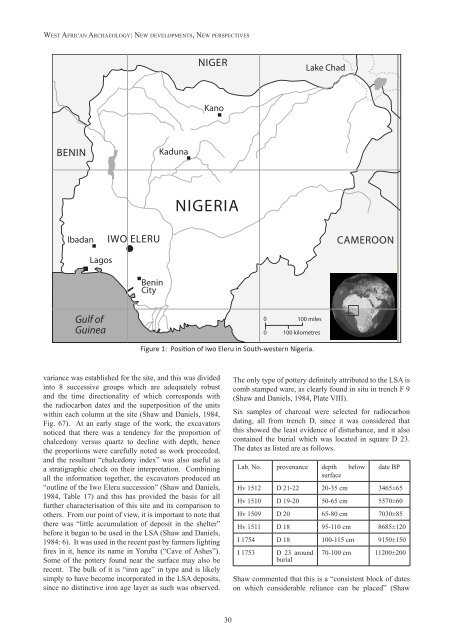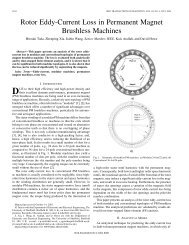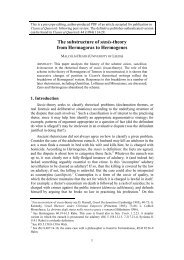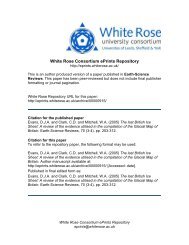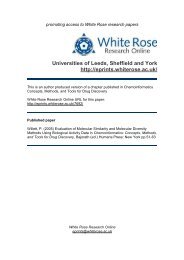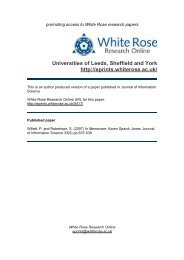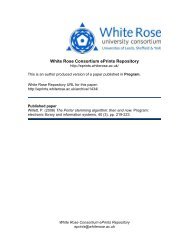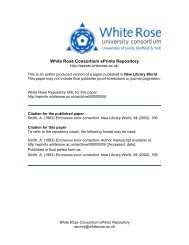The archaeological context of the Iwo Eleru cranium from Nigeria ...
The archaeological context of the Iwo Eleru cranium from Nigeria ...
The archaeological context of the Iwo Eleru cranium from Nigeria ...
Create successful ePaper yourself
Turn your PDF publications into a flip-book with our unique Google optimized e-Paper software.
West AfricAn ArchAeology: neW developments, neW perspectives<br />
10˚N<br />
5˚N<br />
BENIN<br />
Ibadan<br />
Lagos<br />
Gulf <strong>of</strong><br />
Guinea<br />
5˚E<br />
IWO ELERU<br />
Benin<br />
City<br />
Kaduna<br />
NIGER<br />
Kano<br />
NIGERIA<br />
variance was established for <strong>the</strong> site, and this was divided<br />
into 8 successive groups which are adequately robust<br />
and <strong>the</strong> time directionality <strong>of</strong> which corresponds with<br />
<strong>the</strong> radiocarbon dates and <strong>the</strong> superposition <strong>of</strong> <strong>the</strong> units<br />
within each column at <strong>the</strong> site (Shaw and Daniels, 1984,<br />
Fig. 67). At an early stage <strong>of</strong> <strong>the</strong> work, <strong>the</strong> excavators<br />
noticed that <strong>the</strong>re was a tendency for <strong>the</strong> proportion <strong>of</strong><br />
chalcedony versus quartz to decline with depth, hence<br />
<strong>the</strong> proportions were carefully noted as work proceeded,<br />
and <strong>the</strong> resultant “chalcedony index” was also useful as<br />
a stratigraphic check on <strong>the</strong>ir interpretation. Combining<br />
all <strong>the</strong> information toge<strong>the</strong>r, <strong>the</strong> excavators produced an<br />
“outline <strong>of</strong> <strong>the</strong> <strong>Iwo</strong> <strong>Eleru</strong> succession” (Shaw and Daniels,<br />
1984, Table 17) and this has provided <strong>the</strong> basis for all<br />
fur<strong>the</strong>r characterisation <strong>of</strong> this site and its comparison to<br />
o<strong>the</strong>rs. From our point <strong>of</strong> view, it is important to note that<br />
<strong>the</strong>re was “little accumulation <strong>of</strong> deposit in <strong>the</strong> shelter”<br />
before it began to be used in <strong>the</strong> LSA (Shaw and Daniels,<br />
1984: 6). It was used in <strong>the</strong> recent past by farmers lighting<br />
fires in it, hence its name in Yoruba (“Cave <strong>of</strong> Ashes”).<br />
Some <strong>of</strong> <strong>the</strong> pottery found near <strong>the</strong> surface may also be<br />
recent. <strong>The</strong> bulk <strong>of</strong> it is “iron age” in type and is likely<br />
simply to have become incorporated in <strong>the</strong> LSA deposits,<br />
since no distinctive iron age layer as such was observed.<br />
30<br />
10˚E<br />
0<br />
0<br />
<strong>The</strong> only type <strong>of</strong> pottery definitely attributed to <strong>the</strong> LSA is<br />
comb stamped ware, as clearly found in situ in trench F 9<br />
(Shaw and Daniels, 1984, Plate VIII).<br />
Six samples <strong>of</strong> charcoal were selected for radiocarbon<br />
dating, all <strong>from</strong> trench D, since it was considered that<br />
this showed <strong>the</strong> least evidence <strong>of</strong> disturbance, and it also<br />
contained <strong>the</strong> burial which was located in square D 23.<br />
<strong>The</strong> dates as listed are as follows.<br />
Lab. No. provenance depth below<br />
surface<br />
date BP<br />
Hv 1512 D 21-22 20-35 cm 3465±65<br />
Hv 1510 D 19-20 50-65 cm 5570±60<br />
Hv 1509 D 20 65-80 cm 7030±85<br />
Hv 1511 D 18 95-110 cm 8685±120<br />
I 1754 D 18 100-115 cm 9150±150<br />
I 1753 D 23 around<br />
burial<br />
Lake Chad<br />
100 miles<br />
100 kilometres<br />
Figure 1: Position <strong>of</strong> <strong>Iwo</strong> <strong>Eleru</strong> in South-western <strong>Nigeria</strong>.<br />
CAMEROON<br />
70-100 cm 11200±200<br />
Shaw commented that this is a “consistent block <strong>of</strong> dates<br />
on which considerable reliance can be placed” (Shaw


